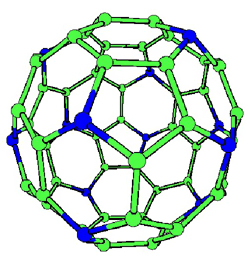Bonding Bucky-Onions

A tough material composed of nanoscale spheres might be just the thing for aerospace and other hi-tech industries. The new material, described in the 26 November print issue of PRL, is made from spherical cages of carbon and nitrogen atoms and has a rare combination of strength and elasticity. Initial tests show that it springs back when squashed and is chemically stable.
Researchers have been looking for ways to use the soccer-ball-shaped molecules of pure carbon known as fullerenes, or buckyballs, since they were first synthesized, about a decade ago. But the solid materials they form, called fullerides, are often weak and easily degraded because the individual spheres hold onto their neighbors through weak van der Waals forces, rather than forming sturdy bonds. Now Lars Hultman of the University of Linköping in Sweden and his colleagues have added nitrogen as their secret ingredient. The nitrogen helps strengthen the fulleride by allowing the spheres to form tight covalent bonds with one another.
The researchers synthesized this new type of fulleride atom by atom, using the technique of magnetron sputtering. They used energetic particles in a plasma to knock, or sputter, carbon atoms from a graphite surface, forming a carbon vapor. The vaporized atoms blended with nitrogen gas that trickled into the vacuum chamber. The material that then condensed onto a surface was composed of buckyballs with some of the carbon atoms replaced by nitrogens. But the buckyballs were not simply hollow spheres: additional layers of carbon developed around the buckyballs to form onion-like, concentric spheres. The team used electron microscopy and other methods to determine that each “onion” was a few nanometers across and contained a core of –a new fullerene, says team member Niklas Hellgren of the University of Illinois in Urbana. A typical onion contains hundreds of carbon atoms in its outer layer, say the researchers, and the onions seem to be strongly bonded to one another, based on structural calculations and mechanical tests.
Hultman and his colleagues measured the mechanical properties by indenting the fulleride with a sharp diamond-tipped probe. According to those experiments, the material is hard yet springy. It’s somewhat harder than titanium nitride, says Hellgren, “but this material’s high elasticity is way superior to that of titanium nitride.” He thinks that the nano-onions “act like tiny rubber balls,” making the material good for protective coverings of hard disks, bearings, and medical implants. Hultman says the team has promising results showing the material to be bio-compatible, as well.
Valery Khabashesku of Rice University in Houston believes the new fulleride to be potentially important, as it provides a recipe for cooking up new materials based on impure fullerenes. He sees lots of possible uses, such as lubricants, semiconductors in flat-panel displays, and non-metallic magnetic materials.
–David Bradley
David Bradley is a writer at sciencebase.com in Cambridge, UK.


